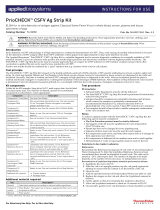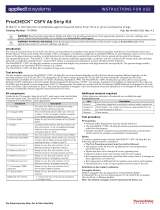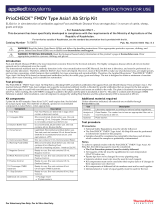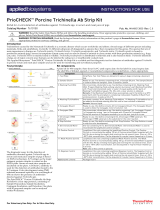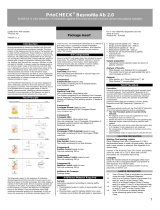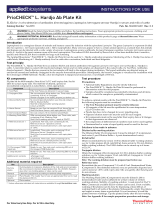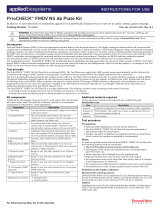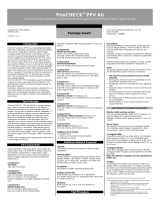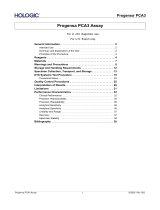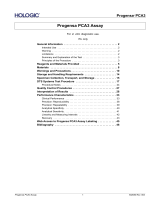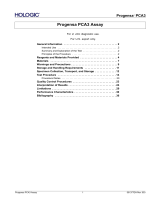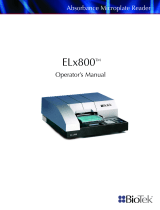Page is loading ...

For Veterinary Use Only. For In Vitro Use Only.
INSTRUCTIONS FOR USE
PrioCHECK™ CSFV Ag Strip Kit
ELISA for
in vitro
detection of antigen against Classical Swine Fever Virus in whole blood, serum, plasma and tissue specimens of pigs
Catalog Number 7610047
Pub. No. MAN0013830 Rev. A.0
WARNING!
Read the Safety Data Sheets (SDSs) and follow the handling instructions. Wear appropriate protective eyewear, clothing, and
gloves. Safety Data Sheets (SDSs) are available from thermofisher.com/support.
WARNING! POTENTIAL BIOHAZARD.
Read the biological hazard safety information at this product’s page at thermofisher.com. Wear
appropriate protective eyewear, clothing, and gloves.
Introduction
Early detection of CSFV infected pigs is of high importance to contain the dissemination of CSFV. Thus, early tracing of possibly infected herds is focused
on the detection of CSFV antigen rather than CSFV antibodies which appear from approximately 14 days post-infection onwards.
The Applied Biosystems™ PrioCHECK™ CSFV Ag Strip Kit is a valuable diagnostic tool to increase diagnostic confidence to eventually establish a CSFV
infection. Priority is given to minimize false positive test results (high specificity and selectivity) combined with the highest possible sensitivity. The
PrioCHECK™ CSFV Ag Strip Kit can be used to examine pig herds that are suspect for CSFV infection. In CSF endemic countries (areas) where often
vaccination is applied the test can be used to trace residual foci of CSFV.
Positive test results should be confirmed by a "gold" standard test (e.g. isolation of the virus in cell culture).
Test principle
The PrioCHECK™ CSFV Ag Strip Kit is based on the double-antibody-sandwich (DAS) principle. CSFV-specific antibodies have been coated to eight-well
strips. In a first step Sample Diluent and Test Sample (whole blood, serum, plasma, leukocyte concentrate or tissue extract) are dispensed to the wells and
incubated. Secondly, the plate is washed and anti-CSFV conjugate of high specificity is dispensed to the wells. After an incubation period the plate is
washed and bound conjugate is visualized by a subsequent incubation with Chromogen (TMB) Substrate. After addition of Stop Solution the color reaction
is terminated. Color development measured optically at a wavelength of 450 nm shows the presence of antigens of classical swine fever virus.
Kit components
2 plate kit for 180 samples. Store kit at 5±3°C until expiry date. See kit label
for actual expiry date. The shelf life of diluted, opened or reconstituted
components is noted below, when appropriate.
Component
Description
1: Test Plate
Two strip Test Plates.
2: Conjugate (30x)
30x concentrated, dilute before use. One vial contains
1.2 mL Conjugate. Diluted conjugate is not stable,
prepare just before use.
3: Dilution Buffer
Ready-to-use. One vial contains 60 mL Dilution Buffer.
4: Conjugate Additive
Ready-to-use. One vial contains 6.0 mL Conjugate
Additive.
5: Demineralized Water
One vial contains 10 mL Demineralized Water.
6: Washing Fluid (200x)
200x concentrated, dilute before use. One vial
contains 60 mL Washing Fluid. Shelf life of the
washing solution: 1 week at 22±3°C.
7: Sample Diluent
Ready-to-use. Two vials, each contains 10 mL
Sample Diluent.
8: Reference Serum 1
Lyophilized. One vial contains 1.5 mL Reference Serum 1
(strong positive control). Shelf life of the reconstituted
Reference Serum 1: until expiry date at −20°C.
9: Reference Serum 2
Lyophilized. One vial contains 1.5 mL Reference
Serum 2 (blank). Shelf life of the reconstituted
Reference Serum 2: until expiry date at −20°C.
10: Reference Serum 3
Lyophilized. One vial contains 1.5 mL Reference Serum 3
(weak positive control). Shelf life of the reconstituted
Reference Serum 3: until expiry date at −20°C.
11: Chromogen (TMB)
Substrate
Ready-to-use. One vial contains 60 mL Chromogen
(TMB) Substrate.
12: Stop Solution
Ready-to-use. One vial contains 60 mL Stop Solution.
Additional kit contents
•1 lid to cover the strips during incubation
•Package Insert
Additional material required
Unless otherwise indicated, all materials are available through
thermofisher.com.
Use
Description
General
Laboratory equipment according to national safety regulations.
Analysis of
results
Plate Reader. The reader has to have an appropriate filter set to
read the plates at 450 nm.
Optional
Plate washer.
Test procedure
Precautions
•National Safety Regulations must be strictly followed.
•The PrioCHECK™ CSFV Ag Strip Kit must be performed in laboratories
suited for this purpose.
•Samples should be considered as potentially infectious and all items
which contact the samples as potentially contaminated. For
decontamination Halamid (1%), sodium hydroxide (0.4%) or
glutaraldehyde (1%) can be used (4–5 log CSFV reduction in 6 minutes).
•Test samples should be kept sterile to enable subsequent confirmation
in the virus isolation test.
Notes
To achieve optimal results with the PrioCHECK™ CSFV Ag Strip Kit, the
following aspects must be considered:
•The Test Procedure protocol must be strictly followed.
•All reagents of the kit must be equilibrated to room temperature
(22±3°C) before use.
•Pipette tips have to be changed for every pipetting step.
•Separate solution reservoirs must be used for each reagent.
•Kit components must not be used after their expiry date or if changes in
their appearance are observed.
•Kit components of different kit lot numbers must not be used together.
•Demineralized or water of equal quality must be used for the test.
Solutions to be made in advance
References
Reconstitute the References (Component 8-10) with 1.5 mL Demineralized
Water (Component 5). After the lyophilized Reference Sera have been
reconstituted they should be aliquotted in small vials. The vials can be
stored at −20°C until expiry date. The number of aliquots to be made
depends on the number of test runs (max. 12 independent test runs).
Reconstitution of lyophilized ingredients should be performed as follows:
1. Equilibrate the vial to 22±3°C.
2. With the vial in an upright position, tap the vial gently against the
tabletop to ensure that the content is on the bottom of the vial.
3. Open the vial.
4. Add the specified amount of Demineralized Water (see label on vial).
5. Replace the stopper on the vial and allow the lyophilized material to
dissolve.
6. Gently agitate so that any remaining dry material is dissolved.
7. Allow the lyophilized material to stand for 15 minutes at 22±3°C.
8. Occasionally, gently invert vial (formation of foam should be avoided).
Conjugate dilution
Dilute Conjugate (30x) (Component 2) in Dilution Buffer (Component 3)
supplemented with 20% (v/v) Conjugate Additive; e.g. for two strips
prepare 2.1 mL (add 400 µL Conjugate Additive to 1.63 mL Dilution Buffer,
subsequently, add 70 µL Conjugate (30x)).

thermofisher.com/support | thermofisher.com/askaquestion
thermofisher.com
18 March 2019
Washing solution
The Washing Fluid (Component 6) must be diluted 1:200 in demineralized
water and is sufficient for a final volume of 12 liters washing solution.
Stability of washing solution: 1 week stored at 22±3°C.
Remark: The washing of the wells after incubation is critical. A blank
optical density (OD of Reference 2) of >0.300 most likely can be ascribed to
inadequate washing of the wells. Manual washing of the wells must be
performed at least 6 times: dispense 300 µL washing solution to each well,
empty the wells carefully by tapping the Test Plate and refill. Omit
formation of air bubbles when filling the wells. Take care that after the last
washing any residual washing solution is removed by tapping the Test
Plate on tissue paper. When using automatic washers and blank OD values
>0.300 are obtained, wash manually as described above.
Note: See Appendix B for sample preparation procedure and storage.
Incubation of serum and test sample
1. Label each strip on the Test Plate (Component 1) with a marker pen.
2. Dispense 50 µL Sample Diluent (Component 7) to all wells.
3. Dispense 50 µL of reconstituted reference serum 1 to well A1 and B1.
4. Dispense 50 µL of reconstituted reference serum 2 to well C1 and D1.
5. Dispense 50 µL of reconstituted reference serum 3 to well E1 and F1.
6. Dispense 50 µL of test sample to the remaining wells.
7. Cover and shake the Test Plate gently.
8. Incubate 180±5 minutes at 22±3°C.
Note: When dispensing whole blood samples take care that no residual
sample remains in pipette tip.
Incubation with conjugate
1. Wash the Test Plate 6 times with 300 µL washing solution per well. Tap
the plate firmly after the last wash cycle.
Note: No residual blood should be left in the wells.
2. Dispense 100 µL of the diluted conjugate to all wells.
3. Cover the Test Plate.
4. Incubate 60±5 minutes at 22±3°C.
Incubation with Chromogen (TMB) Substrate
1. Wash the Test Plate 6 times with 300 µL washing solution per well. Tap
the plate firmly after the last wash cycle.
2. Dispense 100 µL Chromogen (TMB) Substrate (Component 11) to all wells.
3. Incubate 15 minutes at 22±3°C. Do not shake.
4. Add 100 µL Stop Solution (Component 12).
5. Mix the contents of the wells of the plate.
Note: Start the addition of Stop Solution 15 minutes after the first well was
filled with Chromogen (TMB) Substrate. Add the Stop Solution in the same
order and the same place as the Chromogen (TMB) Substrate was dispensed.
Reading of the test and calculating the results
1. Measure the optical density (OD) of the wells at 450 nm within
15 minutes after color development has been stopped.
2. Calculate the mean OD450 of wells C1 and D1 (Reference 2 = OD450 blank).
3. Calculate the corrected OD450 of Reference 1 and all samples by
subtracting the OD450 blank.
4. The percentage positivity (PP) of Reference 3 and of the test samples
are calculated according to the formula below.
The corrected OD450 values of all samples are expressed as percentage
positivity (PP) relative to the corrected mean OD450 value of Reference 1.
PP = (corrected OD450 test sample / corrected OD450 Reference 1) × 100
Result interpretation
Validation criteria
1. The OD450 of Reference 2 must be <0.350.
2. The corrected OD450 of Reference 1 must be at least 0.750.
3. The PP of Reference 3 must be >20%.
Note: Not meeting any of these criteria is reason to discard the results of
that specific test run.
Note: If the corrected mean OD450 of Reference 1 is below 0.750 possibly
the Chromogen (TMB) Substrate is too cold. In that case warm the solution
to 22±3°C or incubate up to 30 minutes. If the corrected mean OD450 of
Reference 1 is above 2.000 a shorter incubation period with the Chromogen
(TMB) Substrate is recommended.
Interpretation of the percent positivity
PP = <15%
Negative
No detectable antigen present in the test sample.
PP = ≥15%
Positive
CSFV antigen is present in the test sample.
The presence of CSFV in antigen-positive samples should be confirmed by
virus isolation.
Appendix A - References
1. Ressang, A.A., (1973). Zbl Vet Med B 20:256–271.
2. Wensvoort et al, (1986). Vet Microbiol 12:101–108.
3. Kaden et al, (1999). Berl Münch Tierärtzl Wschr 112:52–57.
4. Martin et al, (1992). Prev Vet Med 14:33–34.
Appendix B - Sample preparation procedure and storage
Several procedures can be followed to prepare a tissue extract for
subsequent testing in the PrioCHECK™ CSFV Ag Strip Kit and virus
isolation in cell culture. The procedure described below is adopted from the
method routinely used at the Reference Laboratory for CSF of the Institute
for Animal Health and Science in the Netherlands.
Blood and plasma samples
Anticoagulant whole blood samples (preferably heparin blood) or plasma
should preferably not be frozen but stored at 5±3°C (max. 7 days) before
testing.
Serum
Serum samples can be tested directly or after storage at −70°C. After
testing, the serum samples can be stored at −70°C (to preserve viable virus).
Preparation of tissue extract
1. Cut 1–2 grams of the tissue in small pieces and grind these into a
homogenous paste using a mortar and pestle and a small amount of
medium. Use sterile sand as an abrasive when necessary.
2. Per gram tissue add 9 mL Earle’s MEM (supplemented with 5 times the
normal concentration of antibiotics streptomycin, penicillin and
mycostatin).
3. Incubate 1 hour at 22±3°C.
4. Centrifuge the suspension for 20±1 minutes at 6000 × g.
5. Carefully collect the supernatant and discard the sediment.
6. Aliquot the suspension in at least 2 vials.
7. Store the vials at −70°C.
Preparation of leukocyte concentrate
Prior to testing, the collected leukocyte fractions of a blood sample is
preferably frozen (−20ºC) and thawed.
1. Dispense 8 mL 0.83% NH4Cl solution in a 15 mL tube.
2. Add 4 mL anticoagulated whole blood sample.
3. Mix the content of the tube and incubate 30 minutes at 22±3°C in order
to obtain complete lysis of the red blood cells.
4. Centrifuge for 10 minutes at 500 × g at 22±3°C.
5. Discard the supernatant.
6. Re-suspend the leukocyte pellet in 400 µL Earle’s MEM (supplemented
with 5% fetal calf serum and antibiotics streptomycin, penicillin and
mycostatin).
7. Store at −70°C (to preserve viable virus).
Customer and technical support
Technical support: visit thermofisher.com/askaquestion
Visit thermofisher.com/support for the latest in services and support,
including:
• Worldwide contact telephone numbers
• Order and web support
• User guides, manuals, and protocols
• Certificates of Analysis
• Safety Data Sheets (SDSs; also known as MSDSs)
NOTE: For SDSs for reagents and chemicals from other manufacturers,
contact the manufacturer.
Limited product warranty
Life Technologies Corporation and/or its affiliate(s) warrant their products
as set forth in the Life Technologies' General Terms and Conditions of Sale
found on Life Technologies' website at www.thermofisher.com
/us/en/home/global/terms-and-conditions.html. If you have any questions,
please contact Life Technologies at thermofisher.com/support.
Prionics Lelystad B.V. | Platinastraat 33 | 8211 AR Lelystad | The Netherlands
The information in this guide is subject to change without notice.
DISCLAIMER: TO THE EXTENT ALLOWED BY LAW, LIFE TECHNOLOGIES AND/OR ITS AFFILIATE(S)
WILL NOT BE LIABLE FOR SPECIAL, INCIDENTAL, INDIRECT, PUNITIVE, MULTIPLE, OR
CONSEQUENTIAL DAMAGES IN CONNECTION WITH OR ARISING FROM THIS DOCUMENT,
INCLUDING YOUR USE OF IT.
Revision history of Pub. No. MAN0013830 (English)
Rev.
Date
Description
A.0 18 March 2019
New document. Converted the legacy document (PrioCHECK CSFV Ag
7610047_v1.1_e.doc) to the current document template, with associated
updates to the publication number, limited license information,
warranty, trademarks, and logos.
Important Licensing Information: These products may be covered by one or more Limited Use Label
Licenses. By use of these products, you accept the terms and conditions of all applicable Limited Use
Label Licenses.
©2019 Thermo Fisher Scientific Inc. All rights reserved. All trademarks are the property of Thermo
Fisher Scientific and its subsidiaries unless otherwise specified.
/
